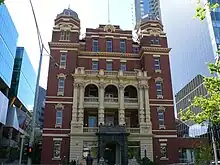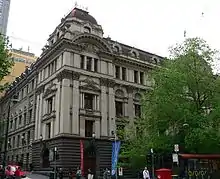
John James Clark (23 January 1838 – 25 June 1915), an Australian architect, was born in Liverpool, England. Clark's 30 years in public service, in combination with 33 in private practice, produced some of Australia's most notable public buildings, as well as at least one prominent building in New Zealand.[1]
Biography
John James Clark, commonly referred to as JJ,[2] was born in Liverpool, England on 23 January 1838 to parents George and Mary Clark. Clark was one of nine children.[3] The family relocated from Liverpool to Melbourne, Australia in March 1852, in hopes of capitalising on the Victorian gold rush.[4] Prior to leaving he had attended Collegiate College, Liverpool,[5] where at thirteen he won first prize for drawing a finely detailed map of Liverpool – every street, all public buildings and docks,[6] Whilst his father and older brother sought reward working in the gold fields, 14-year-old Clark pursued his interest in architecture and on the basis of his revealed abilities, was employed on 26 April 1852 as a draftsman for the Colonial Architect's Office.[7] Clark continued in public service until 1878 when he was retrenched in the Black Wednesday dismissals.[4] He took a brief sabbatical in 1858 to tour Europe[8]
In 1865 Clark married Mary Taylor Watmuff (1844–1871)[4] they remained married until her early death at the age of 26 in 1871.[9] The couple had one child, Edward James, in 1868. They had moved into the East Melbourne home he had designed for the family in early 1870. In 1889 when Edward was 21, Clark took him on a tour of Europe and America, mirroring that of the one Clark took in his own youth. An artistic pursuit learning under, and becoming a friend of, Louis Buvelot.
In 1880 Clark set up private practice in central Melbourne.[4] Between 1881 and 1896 Clark relocated several times between Victoria, New South Wales, Queensland and Western Australia in pursuit of commissions and employment. One of Clark's most notable achievements, during this time, was his appointment as Queensland Colonial Architect. Results of this work scattered across Australia.
In 1896 Clark and his son formed a professional partnership that lasted until his death,[10] and saw them complete works in Perth, Brisbane, Melbourne and Auckland, New Zealand. Clark died at his sons residence in St Kilda, Melbourne on 25 June 1915.
Clark is the subject of a biography published in 2012 by NewSouth books.
Works

- Old Treasury Building
Old Treasury Building is considered by many as one of the finest examples of Renaissance Revival architecture in Melbourne. Clark began designing this building in 1857 when he was nineteen. Construction began in 1858 using bluestone, sourced from Broadmeadows for its foundations, and sandstone, from Bacchus Marsh, for its intricate external facade. The building was completed in 1862. Originally the treasury was designed to hold Victoria's state gold, and also offices major colonial leaders.[8] In 1874 the Treasury offices were relocated, however the building was still used weekly for meetings with the Governor General. In 1992 the building was restored, and from 2005 it was the home of the City Museum.
- Melbourne City Baths
Designed by Clark and his son Edward James in 1904, the Melbourne City Baths were the result of a winning competition entry to redesign the existing baths.
A significant example of the Edwardian Baroque style, the building uses a bold two tone palette of red brick and cream yellow rendered concrete. The highly articulated facade wraps around the corners of the site and displays multiple classical instances of cupolas, archways and triangular pediments that is considered by some as 'Federation Freestyle'. These motifs also reflected a mesh of architectural styles popular in England and America at that time.

- Melbourne Hospital (which in 1946 became the Queen Victoria Memorial Hospital)
Clark and son Edward's original design for the Melbourne Hospital occupied an entire block in the Melbourne central business district. In later years Queen Victoria Hospital was relocated and subsequently a significant portion of the building was deconstructed. Currently all that remains of the original design is the central of three pavilions that fronted Lonsdale Street, which is now known as the Queen Victoria Women's Centre the rest of the block becoming the Queen Victoria Village. The hospital was completed in 1913 in an Edwardian Baroque style. The design worked as a network of pavilions connected by a large central corridor that ran through the site. Raised upon a bluestone base the red brick 'blood & bandage'[11] building is ornamented with rendered concrete flanked by cupola topped turrets.
Further notable works



Victoria, Melbourne
- 1856 The Government Printing Office
- 1858 The Old Treasury Building
- 1860 The Port Melbourne Court House (originally known as Sandridge Police Court)[12]
- 1871 The Royal Mint
- 1874 The Victorian Titles Office
- 1874 The Supreme Court
- 1874 Government House
- 1876 The Customs House
- 1903 The City Baths
- 1907 Women's Hospital
- 1907 Carlton Refuge
- 1912 Melbourne Hospital which in 1946 became the Queen Victoria Hospital (partially demolished in 1994)
- - The Port Melbourne Post Office
Victoria, Regional
- 1864 Aradale Mental Hospital (as assistant of G. W. Vivian)
- 1904 The Ballarat National Mutual Building
- - The Geelong Customs House
- - The Geelong Supreme Court
- - Beechworth Mental Hospital[13]
- - The Sale Court House
- - The Rutherglen Court House
- - The Bright Post Office
- - The Castlemaine Post Office
- - The Yackandandah Post Office
- - The Kilmore Post Office




Queensland
- 1894 The Brisbane Children's Hospital
- 1885 The Brisbane Treasury Building
- 1885 Townsville Post and Telegraph Office
- 1885 Townsville Hospital
- 1885 Charters Towers Courthouse
- 1885 Mackay Courthouse
- 1885 Kangaroo Point Immigration Centre (Yungaba Immigration Centre)[14][15]
- 1895 The Booroodabin Public Baths
- 1901 Brisbane Central railway station
- 1901 an unexecuted design for the Townsville railway station
- - Gympie Town Hall (first stage)
- - Warwick Town Hall
- - Maryborough railway station
- - Brisbane Masonic Memorial Temple
New South Wales
- 1899 A new scheme for the Newcastle Hospital (of which only the Nurses' Quarters and operating Theatre were built)
- 1903 The Maitland Hospital
- 1862 A unexecuted design for the Sydney Free Public Library[16]
- 1881 The Waverley Town Hall (unexecuted)
- 1881 The Orange Town Hall[17]
- 1880 The Wagga Wagga Town Hall (unexecuted)
Western Australia
- 1897 Perth St Andrew's Presbyterian Church
- 1897 Fremantle Town Hall, alterations and extensions
- 1898 Perth Royal Children's Hospital (unexecuted)
- 1898 Vasse Butter Factory[18]
New Zealand
- 1907 Auckland Town Hall
- - A design for the Auckland Supreme Court
- - A design for a Christchurch Court House
Awards
Clark placed in 38 of the 47 competitions he entered throughout his career; of these, 24 were first placements.[4]
Clark's obituary stated his partnership with son Edward James Clark, became his most professionally successfully period in respect to competition wins with the firm winning in succession competitions for:[10]
- Fremantle Town Hall Auditorium Alterations (Fremantle, 1897)
- Saint Andrew's Presbyterian Church (Perth, 1897)
- Royal Children's Hospital (Perth, 1898)
- Newcastle Hospital (Newcastle, 1899)
- Maitland Hospital (Maitland, 1903)
- The City Baths (Melbourne, 1903)
Additionally in later years the firm successful campaigned for
- National Mutual Building (Ballarat, 1904)
- Women's Hospital (Melbourne, 1907)
- Carlton Refuge (Melbourne, 1907)
- Auckland Town Hall (Auckland, 1907 )
- Melbourne Hospital (Melbourne, 1912)
His other competition awards were produced from individual work, partnerships and associations with architectural firms.
References
- ↑ Dodd, Andrew, John James Clark: Public Architect in Australia, unpublished PhD thesis, University of Melbourne 2009.
- ↑ "The Conversation – was there an Australian architectural renaissance?". Australian Broadcasting Corporation. 10 May 2012. Archived from the original on 24 July 2012. Retrieved 8 June 2012.
- ↑ Clark, Margaret (1993). The Unwin Clark Colonials. Wanneroo, W.A.
{{cite book}}: CS1 maint: location missing publisher (link) - 1 2 3 4 5 "Clark, John James (1838–1915)". Australian Dictionary of Biography. National Centre of Biography, Australian National University. Archived from the original on 10 March 2011. Retrieved 15 April 2010.
- ↑ RECORDS OF LIVERPOOL COLLEGIATE SCHOOL | The National Archives
- ↑ "Reproduction print of a map of Liverpool, England, drawn by J. J. Clark in 1851, aged 13. Reproduction published by the Royal Historical Society of Victoria from the original in their collection. – No. 86 December 2010".
- ↑ "Unknown Genius : News : The University of Melbourne". Archived from the original on 2 April 2010. Retrieved 15 April 2010.
- 1 2 "City Museum Melbourne". Archived from the original on 24 November 2009. Retrieved 15 April 2010.
- ↑ "Family Notices". The Argus. Melbourne. 14 March 1871. p. 4. Retrieved 6 September 2013 – via National Library of Australia.
- 1 2 "DEATH OF LEADING ARCHITECT". The Argus. Melbourne. 26 June 1915. p. 16. Retrieved 15 September 2013 – via National Library of Australia.
- ↑ Goad, P. 2006. Melbourne Architecture. Watermark Press: New South Wales.
- ↑ "Sandridge Court House". Port Melbourne Historical and Preservation Society. Retrieved 23 August 2023.
- ↑ "J.J.Clark". PocketOz. Retrieved 12 May 2022.
- ↑ "Yungaba Immigration Centre (entry 600245)". Queensland Heritage Register. Queensland Heritage Council. Retrieved 15 August 2015.
- ↑ "THE NEW IMMIGRATION DEPOT". The Brisbane Courier. 13 July 1887. p. 6. Retrieved 15 August 2015 – via National Library of Australia.
- ↑ Dodd, Andrew (1 December 2010). "J. J. Clark: child prodigy architect and his winning but ill-fated design for a Free Public Library in Sydney". State Library Victoria. La Trobe Journal. Retrieved 23 August 2023.
- ↑ "ORANGE". The Sydney Morning Herald (NSW : 1842 - 1954). 25 June 1881. Retrieved 23 August 2023.
- ↑ "THE VASSE BUTTER FACTORY". The West Australian. Perth. 21 May 1898. p. 2. Retrieved 6 September 2013 – via National Library of Australia.
Further reading
Dodd, Andrew (2012): JJ Clark: Architect of the Australian Renaissance, University of New South Wales Press
Taylor, Florence (12 June 1917). "J.J. Clark: An Architectural Giant", Building, vol 20, no 118, pp 51–66. Retrieved 25 June 2022 – via State Library of Victoria.
External links
- "DEATH OF LEADING ARCHITECT". The Argus. Melbourne. 26 June 1915. p. 16. Retrieved 6 September 2013 – via National Library of Australia.
